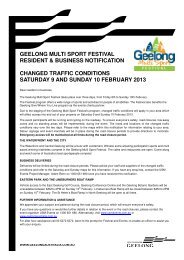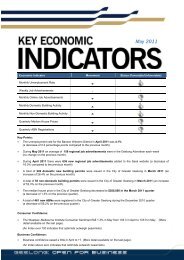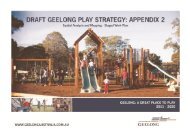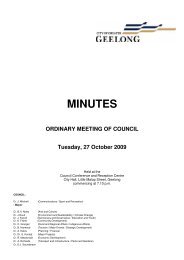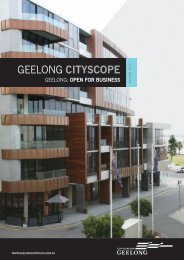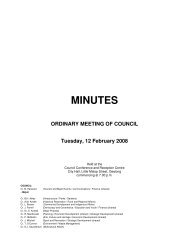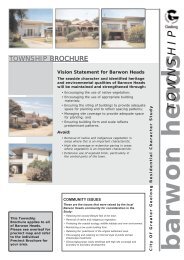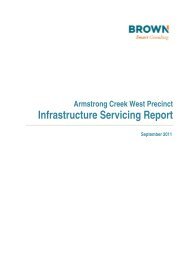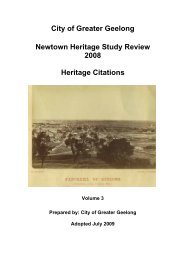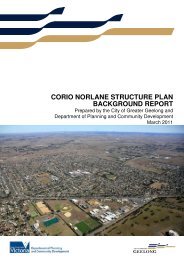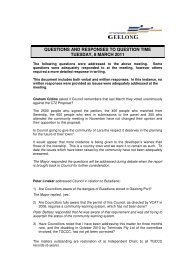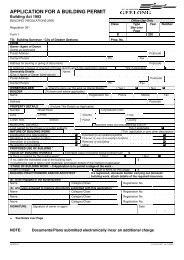ANNUAL REPORT 2007-2008 CITY OF GREATER GEELONG
ANNUAL REPORT 2007-2008 CITY OF GREATER GEELONG
ANNUAL REPORT 2007-2008 CITY OF GREATER GEELONG
You also want an ePaper? Increase the reach of your titles
YUMPU automatically turns print PDFs into web optimized ePapers that Google loves.
<strong>CITY</strong> <strong>OF</strong> <strong>GREATER</strong> <strong>GEELONG</strong><br />
NOTES TO THE FINANCIAL <strong>REPORT</strong> FOR THE YEAR ENDED 30 JUNE <strong>2008</strong><br />
1 Significant Accounting Policies (cont’d)<br />
(b) Revenue recognition (cont’d)<br />
Interest Income<br />
Interest is recognised as revenue on a proportional basis<br />
when the payment is due, the value of the payment is<br />
notified, or the payment is received, whichever first<br />
occurs.<br />
(c) Depreciation and amortisation of non-current assets<br />
All non current assets having limited useful lives are<br />
systematically depreciated over their useful lives to the<br />
Council in a manner which reflects consumption of the<br />
service potential in those assets. Estimates of remaining<br />
useful lives and residual values are made on a regular<br />
basis with major asset classes reassessed annually.<br />
Depreciation rates and methods are reviewed annually.<br />
Where infrastructure assets have separate identifiable<br />
components that are subject to regular replacement, these<br />
components are assigned distinct useful lives and residual<br />
values and a separate depreciation rate is determined for<br />
each component.<br />
Road earthworks are not depreciated because they have<br />
an indefinite useful life.<br />
Depreciation is provided on a straight line basis using a<br />
range of rates which are reviewed annually.<br />
Major depreciation periods used are listed and are<br />
consistent with the prior year:<br />
Buildings<br />
Plant and Equipment<br />
Heavy Plant and Equipment,<br />
Commercial Vehicles<br />
Furniture and Fittings<br />
Personal Computers<br />
Computer Equipment<br />
Software<br />
Light Motor Vehicles<br />
Infrastructure<br />
Spray Seal<br />
Asphalt Seal<br />
Pavement<br />
Drainage<br />
Kerbs and Channel<br />
Footpaths and Bike paths<br />
Recreation<br />
(d) Repairs and maintenance<br />
Period<br />
20-100 years<br />
10 years<br />
10 years<br />
3 years<br />
4-5 years<br />
4 years<br />
6.67 years<br />
12 years<br />
25 years<br />
80 years<br />
100 years<br />
60 years<br />
50 years<br />
7-80 years<br />
Routine maintenance, repair costs, and minor renewal<br />
costs are expensed as incurred. Where the repair relates<br />
to the replacement of a component of an asset and the<br />
cost exceeds the capitalisation threshold the cost is<br />
capitalised and depreciated. The carrying value of the<br />
replaced asset is expensed.<br />
(e) Borrowing costs<br />
Borrowing costs are recognised as an expense in the<br />
period in which they are incurred.<br />
Borrowing costs include interest on bank overdrafts,<br />
interest on borrowings, and finance lease charges.<br />
(f) Recognition and measurement of assets<br />
Acquisition<br />
The purchase method of accounting is used for all<br />
acquisitions of assets, being the fair value of assets<br />
provided as consideration at the date of acquisition<br />
plus any incidental costs attributable to the acquisition.<br />
Non-monetary assets received in the form of grants or<br />
donations or gifted assets are recognised as assets and<br />
revenues at their fair value at the date of receipt.<br />
Where assets are constructed by Council, cost includes all<br />
materials used in construction, direct labour, borrowing<br />
costs incurred during construction, and an appropriate<br />
share of directly attributable variable and fixed overheads.<br />
Fair value is the amount for which the asset could be<br />
exchanged between knowledgeable willing parties in an<br />
arm's length transaction. Where there is no market,<br />
depreciated replacement value approximates fair value.<br />
In accordance with Council's Asset Accounting Policy, the<br />
threshold applied when recognising assets within an<br />
applicable asset class is $1,000 and is consistent with<br />
the prior year.<br />
144



